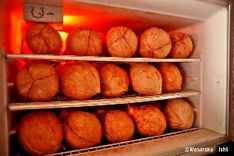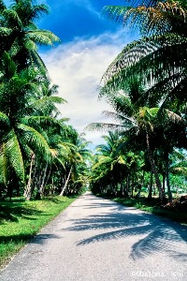近日公開いたします
近日公開いたします
近日公開いたします
近日公開いたします
Chapter 3 Coconuts
Tree of Life
When we speak of a 'coconut tree,' it brings to mind a tall tree with serrated green leaves and plentiful fruits. The coconut palm, an image recognized by everyone from children to adults, is the tree that comes to mind. For islanders, the coconut palm is the 'water that sustains life' and the 'supporting tree of life.' Without it, island-to-island travel would be challenging.
Elders from Yap Island proudly proclaim, 'With coconut trees, we can survive anywhere.' These words are not an exaggeration. They truly make full use of the coconut tree without wasting any part of it. It is indeed the 'tree of life.'
The personification of the coconut palm in folklore and its appearance in myths reflect the vital importance of the coconut palm in the lives of islands that have few useful plants.
■The Significance of the Tree of Life
There are approximately 140 genera and nearly 2,000 species of palms worldwide, including varieties like Sago Palm and Oil Palm belonging to the palm family in Japan. In Micronesia, while there are various palms such as Sago, Betel, Betel nut, Nipa, and Pandanus, the Coconut Palm remains the most prevalent.
The origin of the Coconut Palm remains debatable, with theories suggesting it originated in Melanesia, Southeast Asia, South Africa, or even the Americas. However, it is certain that it traveled alongside ethnic migrations on seafaring canoes to reach new territories. During prehistoric times, voyagers carried coconuts on their canoes as essential provisions for their journeys across the seas. While not all movements relied solely on coconuts, the migration of ethnic groups would have been impractical without them.
The exact origins of the Coconut Palms in Micronesia remain uncertain. Some were naturally dispersed by drifting seeds carried by ocean currents, while others were intentionally planted on uninhabited islands by human hands. It's theorized that when coconuts planted on these uninhabited islands matured, people migrated to these islands using canoes. Presently, many coconut groves on islands mainly result from deliberate plantation efforts.
The establishment of coconut plantations began during the German colonial era for copra extraction and continued during the Japanese colonial rule. The beautiful coconut groves visible in Micronesia today often trace their origins back to legacies of former colonial administrations.
Coconuts flower within a few years of germination, producing 10 to 20 fruits per tree annually, and can bear fruit for over 50 years. With just a few coconut trees, one can secure the basic necessities for food and drink.
Moreover, coconuts boast diverse uses, serving as beverages, baby food, preservatives, seasonings, oils, alcoholic drinks, sweeteners, vegetables, livestock feed, construction materials, baskets, mats, toys, tableware, scrubbers, thatching materials, fire starters, toothpicks, brooms, ropes, medicines, adornments, and even in spiritual practices. Few plants exhibit such versatile applications as the coconut.
■Coconut's Fruit as a Barometer
The notion of plentiful coconuts immediately conjures thoughts of quenching one's dry throat, but in reality, coconuts are gradually becoming a commodity for purchase.
In urban areas like Guam and Saipan, coconuts have long transitioned into a market commodity. Even in certain islands within Palau and the Federated States of Micronesia, supermarkets offer old coconuts specifically for making coconut milk, while locals can be seen enjoying coconut juice (priced from $1.50 to $2 per piece) at town restaurants.
When I received many coconuts from a Filipino resident on Pohnpei Island and was puzzled about what to do with them, I was surprised when a local Pohnpeian gladly said, 'I want them!' and happily took them home.
In households residing in towns without edible trees, coconuts, and bananas are bought at the market. Not every home on these southern islands has an unlimited supply of coconut fruits. Thus, peeking into the market gives a clear glimpse into the material civilization of the island. Especially, coconuts serve as a barometer to gauge self-sufficiency.
Conversely, visiting remote islands where coconuts are still an integral part of daily life, coconuts are absent in supermarkets. Here, children from each house climb trees to gather their own coconuts. In these households, coconuts are naturally utilized in various aspects of daily life.
A single cut of a large leaf instantly transforms into baskets or mats, while the core of a withered leaf serves as a toothpick, convenient for checking the doneness of yams. The coconut's fibers form scrubbers, its dried husks act as fuel, and the village kitchen heavily relies on coconuts. The braided coconut fibers, known as 'coconut ropes,' have been indispensable for traditional homes and canoe-making since ancient times.
Propping a large leaf against the eaves creates shelter from the sun, and these leaves are used for roofing materials. Children weave birds and construct pinwheels from these leaves, using large ones as high jump bars for play.
The sheer breadth of its uses is commendable. With ingenuity, anything can be achieved. This is the true essence of an island rich in coconut resources.
⇩ Click or tap on the photos to view captions.
























